Cell-Population Dynamics in Diffuse Gliomas during Gliomagenesis and Its Impact on Patient Survival
Abstract
:Simple Summary
Abstract
1. Introduction
2. Materials and Methods
2.1. General Characteristics
2.2. Histopathological Diagnosis
2.3. Flow Cytometry
2.4. Multiparametric Fluorescent In Situ Hybridization
2.5. Immunostaining
2.6. Confocal Microscopy
2.7. Real-Time Quantitative Polymerase Chain Reaction
2.8. Cell Cultures
2.9. Statistical Analysis
3. Results
3.1. Cell Populations Dynamics in Diffuse Gliomas, IDH-Mut
3.2. MES-like Cell Population Genesis Identification in Diffuse Gliomas, IDH-Mut
3.3. Cell-Population Dynamics in Glioblastomas
3.4. MesGSC and MES-like Cell Population Genesis Identification in Glioblastomas
3.5. Cell Populations Effect on Patient Prognosis
4. Discussion
5. Conclusions
Author Contributions
Funding
Institutional Review Board Statement
Informed Consent Statement
Data Availability Statement
Conflicts of Interest
References
- Mohile, N.A.; Messersmith, H.; Gatson, N.T.; Hottinger, A.F.; Lassman, A.; Morton, J.; Ney, D.; Nghiemphu, P.L.; Olar, A.; Olson, J.; et al. Therapy for Diffuse Astrocytic and Oligodendroglial Tumors in Adults: ASCO-SNO Guideline. J. Clin. Oncol. 2022, 40, 403–426. [Google Scholar] [CrossRef]
- Varn, F.S.; Johnson, K.C.; Martinek, J.; Huse, J.T.; Nasrallah, M.P.; Wesseling, P.; Cooper, L.A.D.; Malta, T.M.; Wade, T.E.; Sabedot, T.S.; et al. Glioma progression is shaped by genetic evolution and microenvironment interactions. Cell 2022, 185, 2184–2199.e16. [Google Scholar] [CrossRef]
- Ostrom, Q.T.; Price, M.; Ryan, K.; Edelson, J.; Neff, C.; Cioffi, G.; Waite, K.A.; Kruchko, C.; Barnholtz-Sloan, J.S. CBTRUS Statistical Report: Pediatric Brain Tumor Foundation Childhood and Adolescent Primary Brain and Other Central Nervous System Tumors Diagnosed in the United States in 2014-2018. Neuro Oncol. 2022, 24, iii1–iii38. [Google Scholar] [CrossRef]
- Ostrom, Q.T.; Cioffi, G.; Waite, K.; Kruchko, C.; Barnholtz-Sloan, J.S. CBTRUS Statistical Report: Primary Brain and Other Central Nervous System Tumors Diagnosed in the United States in 2014-2018. Neuro Oncol. 2021, 23, iii1–iii105. [Google Scholar] [CrossRef]
- Louis, D.N.; Perry, A.; Wesseling, P.; Brat, D.J.; Cree, I.A.; Figarella-Branger, D.; Hawkins, C.; Ng, H.K.; Pfister, S.M.; Reifenberger, G.; et al. The 2021 WHO Classification of Tumors of the Central Nervous System: A summary. Neuro Oncol. 2021, 23, 1231–1251. [Google Scholar] [CrossRef]
- Reifenberger, G.; Wirsching, H.G.; Knobbe-Thomsen, C.B.; Weller, M. Advances in the molecular genetics of gliomas - implications for classification and therapy. Nat. Rev. Clin. Oncol. 2017, 14, 434–452. [Google Scholar] [CrossRef]
- Wirsching, H.G.; Weller, M. The Role of Molecular Diagnostics in the Management of Patients with Gliomas. Curr. Treat. Options Oncol. 2016, 17, 51. [Google Scholar] [CrossRef] [Green Version]
- Dubbink, H.J.; Atmodimedjo, P.N.; Kros, J.M.; French, P.J.; Sanson, M.; Idbaih, A.; Wesseling, P.; Enting, R.; Spliet, W.; Tijssen, C.; et al. Molecular classification of anaplastic oligodendroglioma using next-generation sequencing: A report of the prospective randomized EORTC Brain Tumor Group 26951 phase III trial. Neuro Oncol. 2016, 18, 388–400. [Google Scholar] [CrossRef] [Green Version]
- Yang, K.; Wu, Z.; Zhang, H.; Zhang, N.; Wu, W.; Wang, Z.; Dai, Z.; Zhang, X.; Zhang, L.; Peng, Y.; et al. Glioma targeted therapy: Insight into future of molecular approaches. Mol. Cancer 2022, 21, 39. [Google Scholar] [CrossRef]
- Molinaro, A.M.; Taylor, J.W.; Wiencke, J.K.; Wrensch, M.R. Genetic and molecular epidemiology of adult diffuse glioma. Nat. Rev. Neurol. 2019, 15, 405–417. [Google Scholar] [CrossRef]
- Venteicher, A.S.; Tirosh, I.; Hebert, C.; Yizhak, K.; Neftel, C.; Filbin, M.G.; Hovestadt, V.; Escalante, L.E.; Shaw, M.L.; Rodman, C.; et al. Decoupling genetics, lineages, and microenvironment in IDH-mutant gliomas by single-cell RNA-seq. Science 2017, 355, eaai8478. [Google Scholar] [CrossRef] [PubMed] [Green Version]
- Neftel, C.; Laffy, J.; Filbin, M.G.; Hara, T.; Shore, M.E.; Rahme, G.J.; Richman, A.R.; Silverbush, D.; Shaw, M.L.; Hebert, C.M.; et al. An Integrative Model of Cellular States, Plasticity, and Genetics for Glioblastoma. Cell 2019, 178, 835–849.e21. [Google Scholar] [CrossRef] [PubMed]
- Patel, A.P.; Tirosh, I.; Trombetta, J.J.; Shalek, A.K.; Gillespie, S.M.; Wakimoto, H.; Cahill, D.P.; Nahed, B.V.; Curry, W.T.; Martuza, R.L.; et al. Single-cell RNA-seq highlights intratumoral heterogeneity in primary glioblastoma. Science 2014, 344, 1396–1401. [Google Scholar] [CrossRef] [Green Version]
- Nikitin, P.V.; Musina, G.R.; Polozov, V.N.; Goreiko, D.N.; Krasnovsky, V.M.; Werkenbark, L.; Kjelin, M.; Timashev, P.S. Development of Glioblastoma from Stem Cells to a Full-Fledged Tumor. Turk Patoloji Derg 2022. [CrossRef]
- Ma, Q.; Long, W.; Xing, C.; Chu, J.; Luo, M.; Wang, H.Y.; Liu, Q.; Wang, R.F. Cancer Stem Cells and Immunosuppressive Microenvironment in Glioma. Front. Immunol. 2018, 9, 2924. [Google Scholar] [CrossRef] [Green Version]
- Silver, A.; Feier, D.; Ghosh, T.; Rahman, M.; Huang, J.; Sarkisian, M.R.; Deleyrolle, L.P. Heterogeneity of glioblastoma stem cells in the context of the immune microenvironment and geospatial organization. Front. Oncol. 2022, 12, 1022716. [Google Scholar] [CrossRef]
- Vora, P.; Venugopal, C.; Salim, S.K.; Tatari, N.; Bakhshinyan, D.; Singh, M.; Seyfrid, M.; Upreti, D.; Rentas, S.; Wong, N.; et al. The Rational Development of CD133-Targeting Immunotherapies for Glioblastoma. Cell Stem Cell 2020, 26, 832–844.e6. [Google Scholar] [CrossRef]
- Song, W.S.; Yang, Y.P.; Huang, C.S.; Lu, K.H.; Liu, W.H.; Wu, W.W.; Lee, Y.Y.; Lo, W.L.; Lee, S.D.; Chen, Y.W.; et al. Sox2, a stemness gene, regulates tumor-initiating and drug-resistant properties in CD133-positive glioblastoma stem cells. J. Chin. Med. Assoc. 2016, 79, 538–545. [Google Scholar] [CrossRef] [Green Version]
- Nabors, L.B.; Portnow, J.; Ahluwalia, M.; Baehring, J.; Brem, H.; Brem, S.; Butowski, N.; Campian, J.L.; Clark, S.W.; Fabiano, A.J.; et al. Central Nervous System Cancers, Version 3.2020, NCCN Clinical Practice Guidelines in Oncology. J. Natl. Compr. Canc. Netw. 2020, 18, 1537–1570. [Google Scholar] [CrossRef]
- Weller, M.; van den Bent, M.; Preusser, M.; Le Rhun, E.; Tonn, J.C.; Minniti, G.; Bendszus, M.; Balana, C.; Chinot, O.; Dirven, L.; et al. EANO guidelines on the diagnosis and treatment of diffuse gliomas of adulthood. Nat. Rev. Clin. Oncol. 2021, 18, 170–186. [Google Scholar] [CrossRef]
- Sinkala, M.; Mulder, N.; Patrick Martin, D. Metabolic gene alterations impact the clinical aggressiveness and drug responses of 32 human cancers. Commun. Biol. 2019, 2, 414. [Google Scholar] [CrossRef] [Green Version]
- Pouget, C.; Hergalant, S.; Lardenois, E.; Lacomme, S.; Houlgatte, R.; Carpentier, C.; Dehais, C.; Rech, F.; Taillandier, L.; Sanson, M.; et al. Ki-67 and MCM6 labeling indices are correlated with overall survival in anaplastic oligodendroglioma, IDH1-mutant and 1p/19q-codeleted: A multicenter study from the French POLA network. Brain Pathol. 2020, 30, 465–478. [Google Scholar] [CrossRef]
- Figarella-Branger, D.; Mokhtari, K.; Dehais, C.; Jouvet, A.; Uro-Coste, E.; Colin, C.; Carpentier, C.; Forest, F.; Maurage, C.A.; Vignaud, J.M.; et al. POLA Network. Mitotic index, microvascular proliferation, and necrosis define 3 groups of 1p/19q codeleted anaplastic oligodendrogliomas associated with different genomic alterations. Neuro Oncol. 2014, 16, 1244–1254. [Google Scholar] [CrossRef] [Green Version]
- Mathewson, N.D.; Ashenberg, O.; Tirosh, I.; Gritsch, S.; Perez, E.M.; Marx, S.; Jerby-Arnon, L.; Chanoch-Myers, R.; Hara, T.; Richman, A.R.; et al. Inhibitory CD161 receptor identified in glioma-infiltrating T cells by single-cell analysis. Cell 2021, 184, 1281–1298.e26. [Google Scholar] [CrossRef]
- Chong, D.Q.; Toh, X.Y.; Ho, I.A.; Sia, K.C.; Newman, J.P.; Yulyana, Y.; Ng, W.H.; Lai, S.H.; Ho, M.M.; Dinesh, N.; et al. Combined treatment of Nimotuzumab and rapamycin is effective against temozolomide-resistant human gliomas regardless of the EGFR mutation status. BMC Cancer 2015, 15, 255. [Google Scholar] [CrossRef] [Green Version]
- Nitta, Y.; Shimizu, S.; Shishido-Hara, Y.; Suzuki, K.; Shiokawa, Y.; Nagane, M. Nimotuzumab enhances temozolomide-induced growth suppression of glioma cells expressing mutant EGFR in vivo. Cancer Med. 2016, 5, 486–499. [Google Scholar] [CrossRef] [Green Version]
- Luchman, H.A.; Stechishin, O.D.; Nguyen, S.A.; Lun, X.Q.; Cairncross, J.G.; Weiss, S. Dual mTORC1/2 blockade inhibits glioblastoma brain tumor initiating cells in vitro and in vivo and synergizes with temozolomide to increase orthotopic xenograft survival. Clin. Cancer Res. 2014, 20, 5756–5767. [Google Scholar] [CrossRef] [Green Version]
- Griveau, A.; Seano, G.; Shelton, S.J.; Kupp, R.; Jahangiri, A.; Obernier, K.; Krishnan, S.; Lindberg, O.R.; Yuen, T.J.; Tien, A.C.; et al. A Glial Signature and Wnt7 Signaling Regulate Glioma-Vascular Interactions and Tumor Microenvironment. Cancer Cell 2018, 33, 874–889.e7. [Google Scholar] [CrossRef]

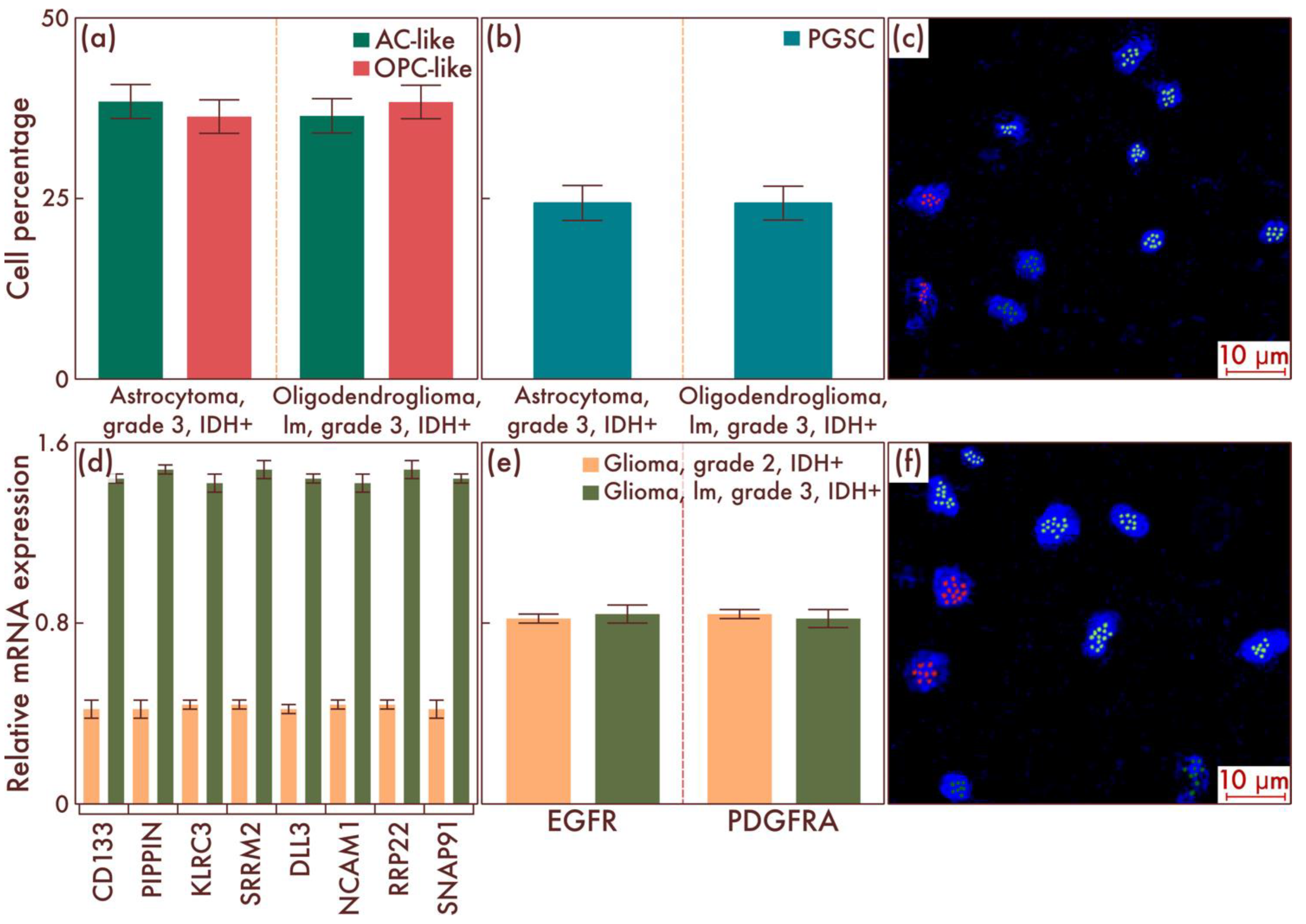
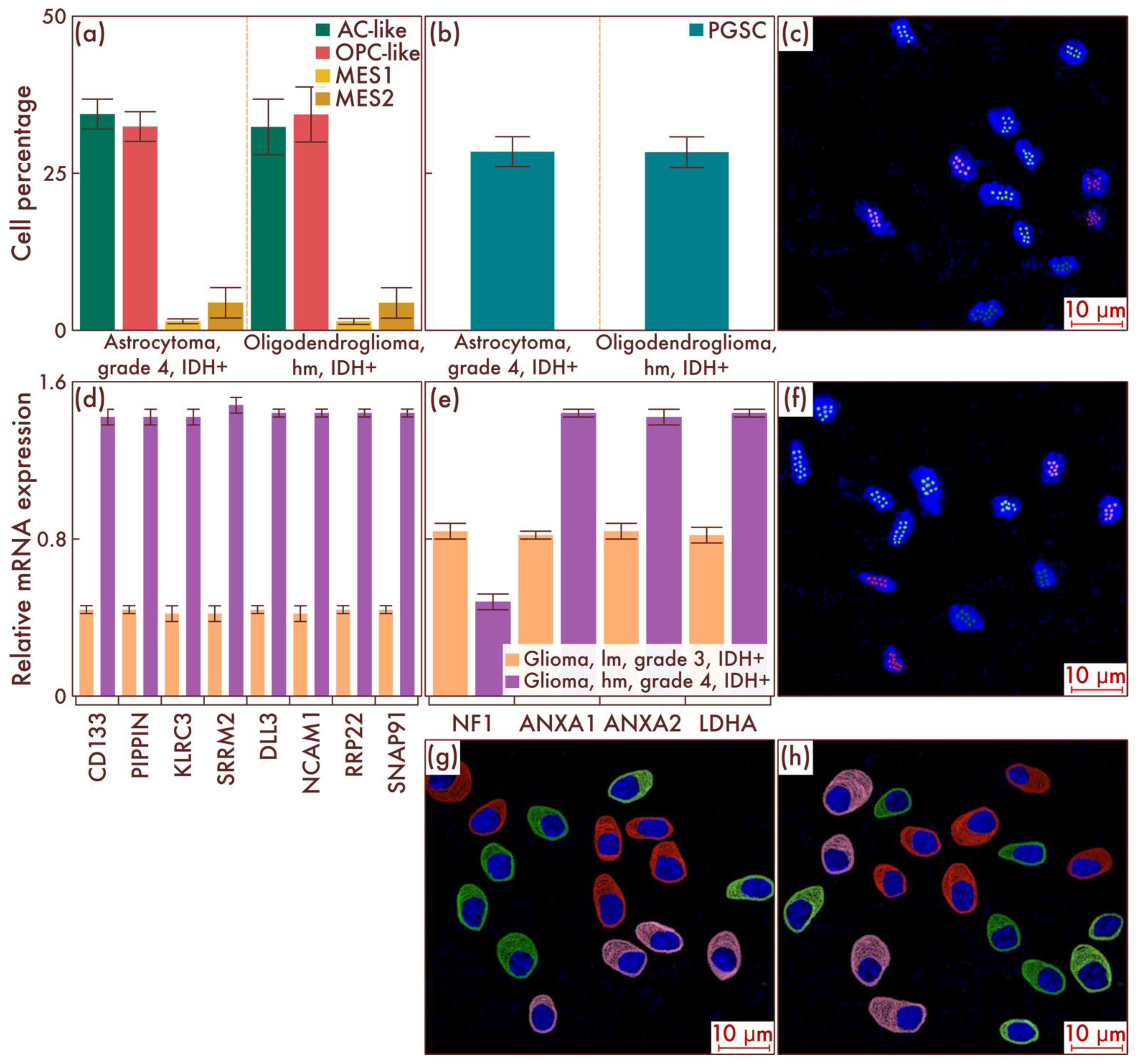

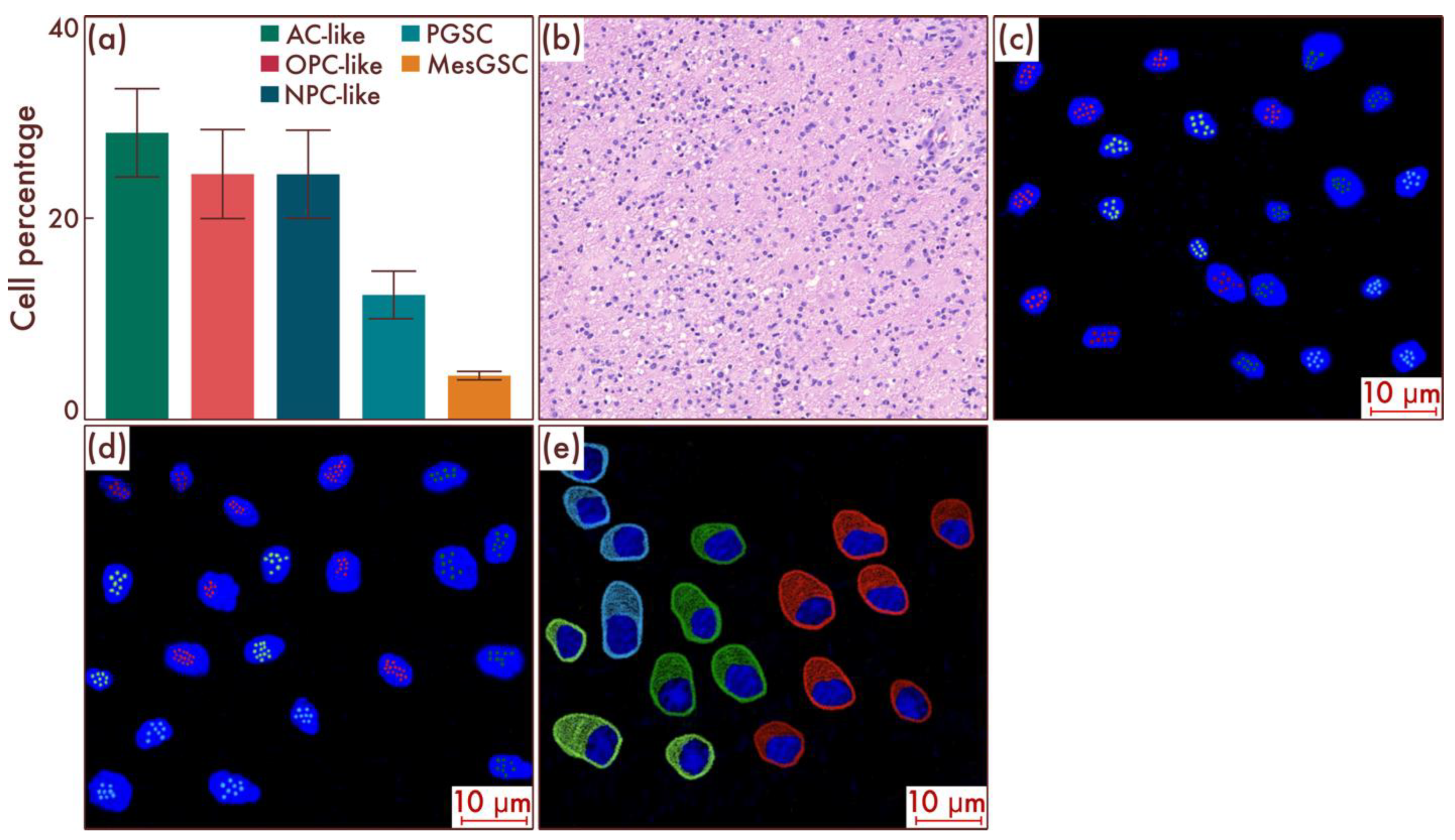
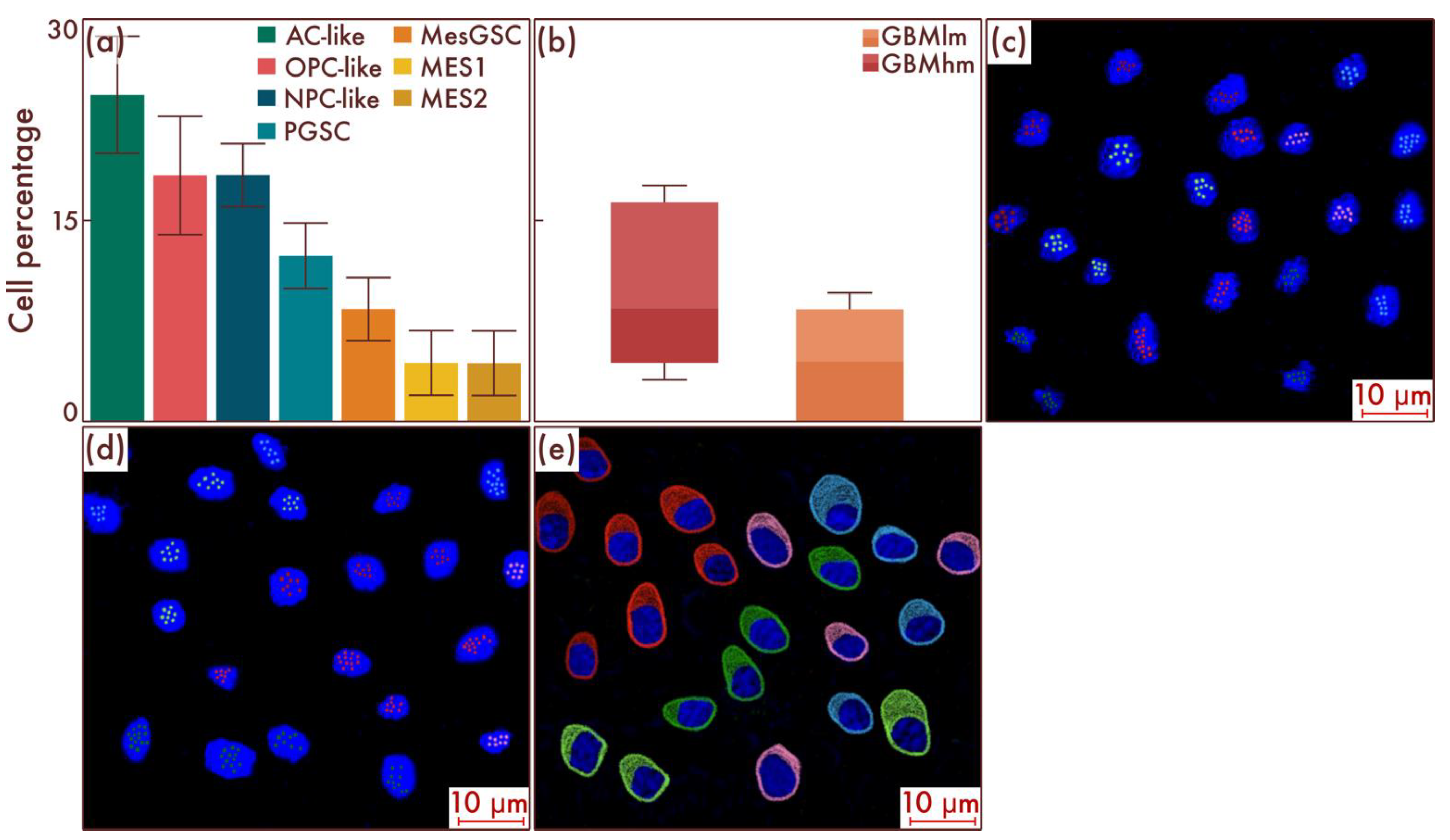
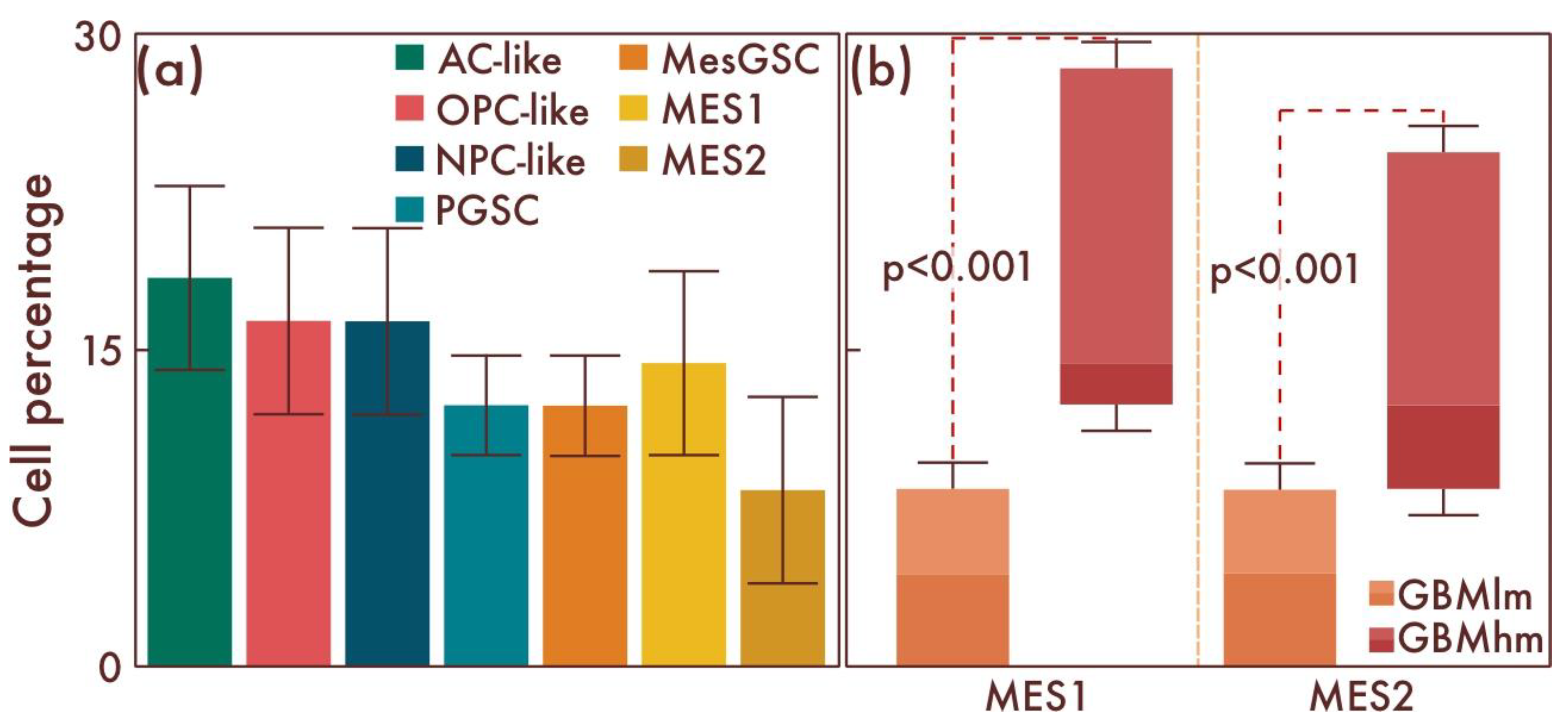

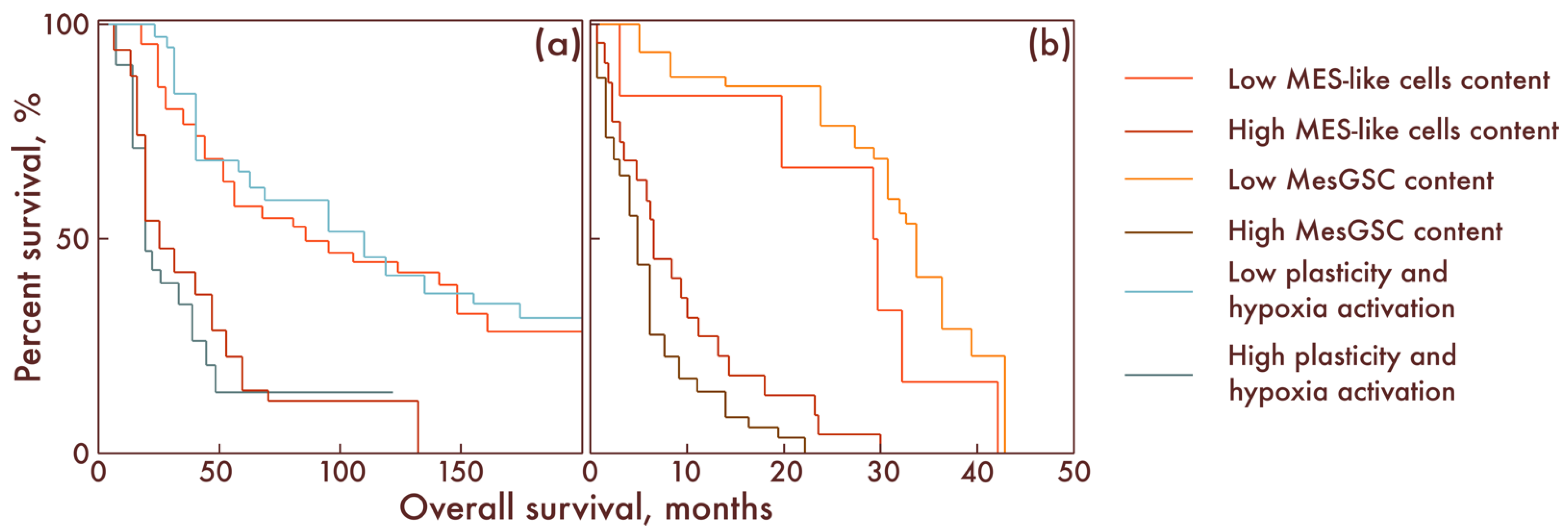
| Astrocytoma, Grade 2, IDH-mut | Astrocytoma, Grade 3, IDH-mut | Astrocytoma, Grade 4, IDH-mut | Oligodendroglioma, Grade 2, IDH-mut | Oligodendroglioma, Grade 3, IDH-mut | Glioblastoma, IDH-wt | |
|---|---|---|---|---|---|---|
| Mean age (years) | 34.8 ± 4.2 | 38.2 ± 8.2 | 48.2 ± 4.8 | 38.0 ± 2.8 | 48.8 ± 4.2 | 68.4 ± 8.6 |
| Men and women ratio (percentage) | 54.58% to 45.42% | 61.54% to 38.46% | 54.84% to 45.16% | 52.00% to 48.00% | 54.18% to 45.82% | 52.86% to 47.14% |
| Most frequent localization | Frontal lobe | Frontal lobe | Frontal lobe | Frontal lobe | Frontal lobe | Temporal lobe |
| Contrast accumulation (percentage) | 2.84% | 62.07% | 94.24% | 12% | 82.76% | 98.14% |
| Disease-free survival (months) | 58.4 | 22.8 | 14.2 | 58.8 | 28.4 | 5.8 |
| Overall survival (months) | 136.8 | 112.2 | 28.8 | 144.2 | 94.2 | 16.4 |
| Genes | Forward | Reverse |
|---|---|---|
| CD133 | AGA-TCC-CCA-CGC-GAG- GGG | CGG-CAC-CTG-GCC- CCG-CCC |
| PIPPIN | CTG-AGG-GCA-GTT-ATC-ATA | GCG-CGA-CCC-TCA-CAT-CAC |
| KLRC3 | GTG-CTG-ACG-TGC-AGC-CCA | GGC-GGG-GTG-CGA-GTG-GCG |
| SRRM2 | TTG-GAG-CCC-GTT-GCG-GCC-CCT-GAG | CGA-GGA-GGC-GTC-GGC-GTC-GGC-TGA |
| DLL3 | GAG-GCG-AGG-CGG-CGG-CCC | GAC-TCG-GGA-GCT-CGA-GCA |
| NCAM1 | CAA-GAC-CTC-TCC-CCC-TCG | TGA-GAG-GGT-GAG-GGA-GCC |
| RRP22 | GCG-AGC-CGG-GTG-GGG-GAG | GCC-CCG-GCG-CGA-GGC-CAA |
| SNAP91 | GGA-GAA-CTG-CCC-AGG-CCG-CCG-AGC | CTC-CGC-GCG-CAC-GCG-CGC-TCG-ACG |
| EGFR | CCT-CGC-CTC-CCT-TCC-CCC | CCG-TTC-CTG-TCG-CGC-GCG |
| PDGFRA | TGA-CAA-CGG-CGT-TCG-CAG | CTG-TAC-TCG-GGT-TCG-CGA |
| NF1 | TTG-GTG-AGG-GGG-GAG-GGC | CTC-GGC-TTC-ACT-CCT-CCC |
| ANXA1 | CAA-CAT-GTG-CCG-CCG-AGG-TGG-CCT | TGC-TCC-TGG-ACC-CTT-GCC-CCC-GGT |
| ANXA2 | CCT-CGG-GCT-TCT-CTT-CGG | GCT-GCC-CGT-GTC-GGG-GGC |
| LDHA | CCC-TCC-CCC-ATT-CCG-CAA | CGA-AAA-TAG-GCC-CCC-GGC |
| SLC2A1 | TTG-AAG-GAA-TAA-AAT-ATC | TCT-TTA-AAT-ATT-TGG-AAT |
| SLC2A2 | CTG-GGA-GGT-GAA-GTA-TAT-GAC-GAT | CCA-AGG-TTC-ATG-TGT-GTT-TCT-GAT |
| SLC2A3 | TGG-GGT-GTG-AGG-CTG-CAC | CAA-CTA-GTC-TGC-TGT-TCA |
| SLC2A4 | TTC-ATA-TTC-GTA-TAG-GGT | TTA-GGT-AAG-TTT-TTG-GGA |
| ADPGK | GGC-CGT-TGG-GTG-CCA-CAG | TGG-TGT-TTG-TTG-TGA-CCA |
| GCK | TTA-GGA-ATT-AGA-GTA-GTT-GGT-AAC | CAC-TTG-TGC-ATT-TTG-GGG-CCA-AAG |
| PFKFB2 | GTG-TGG-AGA-GAT-TTT-AGA | TGT-TTG-CCT-AGG-GTG-GAA |
| PGK1 | GGG-AGG-GAT-TAT-TTA-GAA | GCA-TTG-AGA-GAA-AGG-CTG |
| LDHA | TAG-AAG-GAA-ATT-TGG-AAG | TTT-CTT-GGG-AGA-CCA-GGA |
| SLC16A3 | CGG-GCA-CGG-GGC-CAT-GTA-CAA-CGG | TGC-CGA-CGC-CCC-GGG-GCA-GCG-GCA |
| SLC16A5 | CGT-CCA-GCG-CAA-CCT-GTC | CGC-CGG-GGT-GAG-CGG-CCT |
| SLC16A10 | CTG-CGG-CGC-CTG-GAG-GCT | CGG-CCT-AAT-CCT-GAC-ATC |
| BCAT1 | GCG-TCG-AGC-TGC-GAT-GCC | GAG-ATG-ATG-GAA-GAG-CAG |
| GBE1 | GTC-AAG-CAC-TGA-ATG-AGT-GCA-GAG | TAG-GTG-GGA-TGT-ATA-GGG-AGC-TTA |
| GFPT1 | GAG-GCC-TGG-CAA-AGA-GTT | GAG-GAG-GCA-GAT-GAG-CTC |
| G6PD | CAG-TGC-AGA-GTG-GGA-AAT | TGT-GTC-TGG-GGC-ATA-GAT |
| FADS2 | GCA-CGT-GGG-AGA-AGG-GAG | GAA-CAA-AAA-TGT-GTT-TTA |
| PDHA1 | CCA-GGT-AGA-GGA-GCT-AGG-TAA-GCT | TCA-TTG-GTA-GAA-AAG-AAG-AAG-ATA |
| HSD17B10 | GGA-TTG-AGG-CCT-TGG-AAG | GAA-TTA-GAA-GAA-TAC-GTG |
| Pref-1 | CAT-GGC-TGG-GAA-GGG-AAT | GCC-CAT-TAA-GGC-AGA-AAC |
| ALDH | TAA-ACT-TCA-GCA-ATG-GTG | TAT-CCT-TAC-TTG-GAA-TCC |
| HIF1A | TTC-TTG-TTG-AAG-TTG-GGA | CTG-CTT-GCT-TAA-CTT-TTC |
| NANOG | GTA-GCA-TAT-TTA-AAT-CCA | GAG-TAG-TAA-GTA-GAG-GGA |
| Genes | Diffuse Gliomas, IDH-Mut, Grades 3 and 4 | Diffuse Gliomas, IDH-Mut, Grade 2 |
|---|---|---|
| BCAT1 | 2.84 ± 0.48 | 1.42 ± 0.24 |
| GBE1 | 2.16 ± 0.42 | 1.52 ± 0.18 |
| GFPT1 | 1.92 ± 0.36 | 1.46 ± 0.22 |
| G6PD | 2.64 ± 0.38 | 2.12 ± 0.16 |
| FADS2 | 1.90 ± 0.84 | 0.78 ± 0.14 |
| PDHA1 | 2.24 ± 0.82 | 0.92 ± 0.24 |
| HSD17B10 | 2.44 ± 0.44 | 1.86 ± 0.84 |
| Pref-1 | 2.34 ± 0.36 | 1.52 ± 0.82 |
| ALDH | 2.29 ± 0.94 | 0.74 ± 0.18 |
| HIF1A | 2.28 ± 0.48 | 1.05 ± 0.14 |
| NANOG | 2.32 ± 0.34 | 0.48 ± 0.16 |
Disclaimer/Publisher’s Note: The statements, opinions and data contained in all publications are solely those of the individual author(s) and contributor(s) and not of MDPI and/or the editor(s). MDPI and/or the editor(s) disclaim responsibility for any injury to people or property resulting from any ideas, methods, instructions or products referred to in the content. |
© 2022 by the authors. Licensee MDPI, Basel, Switzerland. This article is an open access article distributed under the terms and conditions of the Creative Commons Attribution (CC BY) license (https://creativecommons.org/licenses/by/4.0/).
Share and Cite
Nikitin, P.V.; Musina, G.R.; Pekov, S.I.; Kuzin, A.A.; Popov, I.A.; Belyaev, A.Y.; Kobyakov, G.L.; Usachev, D.Y.; Nikolaev, V.N.; Mikhailov, V.P. Cell-Population Dynamics in Diffuse Gliomas during Gliomagenesis and Its Impact on Patient Survival. Cancers 2023, 15, 145. https://doi.org/10.3390/cancers15010145
Nikitin PV, Musina GR, Pekov SI, Kuzin AA, Popov IA, Belyaev AY, Kobyakov GL, Usachev DY, Nikolaev VN, Mikhailov VP. Cell-Population Dynamics in Diffuse Gliomas during Gliomagenesis and Its Impact on Patient Survival. Cancers. 2023; 15(1):145. https://doi.org/10.3390/cancers15010145
Chicago/Turabian StyleNikitin, Pavel V., Guzel R. Musina, Stanislav I. Pekov, Andrey A. Kuzin, Igor A. Popov, Artem Y. Belyaev, Gregory L. Kobyakov, Dmitry Y. Usachev, Viktor N. Nikolaev, and Valentin P. Mikhailov. 2023. "Cell-Population Dynamics in Diffuse Gliomas during Gliomagenesis and Its Impact on Patient Survival" Cancers 15, no. 1: 145. https://doi.org/10.3390/cancers15010145





